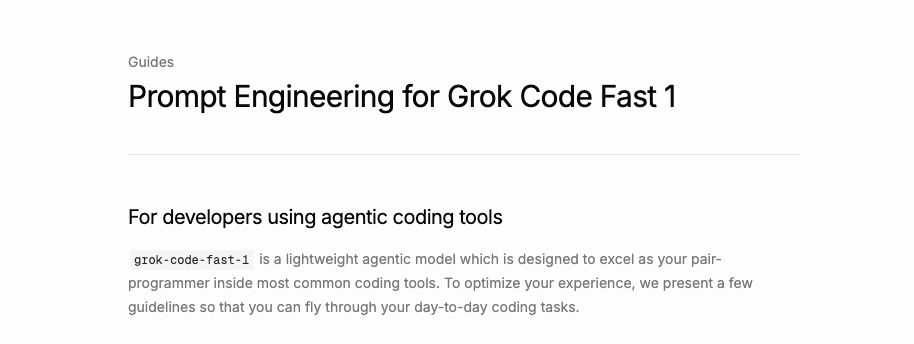xAI's Prompt Engineering Guide for grok-code-fast-1

xAI recently released a prompt engineering guide for their new grok-code-fast-1 model. These guides are awesome ways to learn how to be a better day-to-day prompt engineer, not just with grok.
Below are my takeaways after reading it. They are aimed to help with day-to-day prompt engineering.
Iteration is better than perfection
grok-code-fast-1 runs 4x faster and costs 1/10th of competing models, which fundamentally changes how you should approach prompting. Instead of spending 20 minutes crafting the "perfect" prompt, fire off a quick attempt and refine based on the results. This iterative approach often gets you to a better outcome faster than trying to nail it in one shot.
First attempt: "Add error handling to my database queries"
Refinement: "The previous approach didn't consider the IO heavy process
which can block the main thread. We might want to run it in its own
threadloop such that it does not block the event loop instead of just
using the async lib version"Think agentic, not one-shot
The model is built for multi-step tasks that require tool use and navigation through complex problems. It's not optimized for simple Q&A. Give it meaty tasks that require exploration and multiple actions to complete.
Structure your context
Organization matters. Use XML tags or Markdown headers to clearly delineate different sections of your context. When the model can easily parse what's what, it uses the information more effectively.
## Current Implementation
[paste existing code]
## Requirements
- Must handle concurrent requests
- Should return typed responses
- Needs to integrate with our logging system
## Available Dependencies
- @errors.ts: Custom error definitions
- @logger.ts: Logging utilities
- @types.ts: Type definitionsContext is king
Be surgical with your context selection. Don't dump your entire codebase into the prompt. Instead, specifically point to the files and code sections relevant to your task. Too much irrelevant context leads to unnecessary tangents and decreased performance.
❌ Bad: "Make error handling better"
✅ Good: "My error codes are defined in @errors.ts, can you use that
as reference to add proper error handling and error codes to @sql.ts
where I am making queries"Vague prompts = vague results
Specificity wins. "Create a food tracker" gives you a basic food tracker. "Create a food tracker showing daily calorie breakdown by nutrients with overview and trend analysis" gives you exactly what you need. The extra 10 seconds spent adding detail saves you minutes of back-and-forth refinement.
❌ Vague:
"Create a REST API"
✅ Specific:
"Create a REST API with:
- GET /users - paginated list with filtering by status
- POST /users - create with email validation
- PUT /users/:id - update only name and status fields
- Use Express with TypeScript
- Include request validation middleware
- Return consistent error responses with status codes"The Bottom Line
While these insights come from xAI's guide for grok-code-fast-1, they're universal principles for effective prompt engineering. Whether you're using Claude, GPT-4, or any other model, clear context, explicit goals, structured information, and iterative refinement will consistently improve your results.
The best prompt isn't the one you spend 30 minutes perfecting—it's the one you iterate on three times in 5 minutes.



